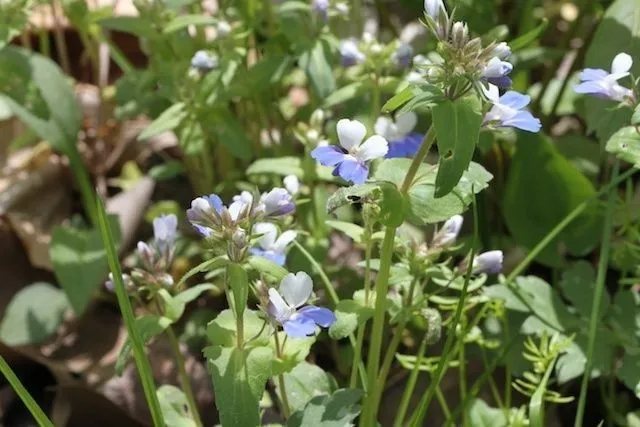
Author: Nutt.
Bibliography: J. Acad. Nat. Sci. Philadelphia 1: 190 (1817)
Year: 1817
Status: accepted
Rank: species
Genus: Collinsia
Vegetable: False
Observations: SE. Canada to C. & E. U.S.A.
The Spring blue eyed mary, known scientifically as Collinsia verna, is a delicate and enchanting plant that has captured the interest of botanists and garden enthusiasts alike. First described by Nutt. in a seminal 1817 publication in the Journal of the Academy of Natural Sciences of Philadelphia, this species has since become a notable member of the Plantaginaceae family.
This charming plant is native to the southeastern regions of Canada and extends its presence through central and eastern parts of the United States. Its geographical range demonstrates its adaptability to varying climates and terrains within these areas.
Collinsia verna is particularly admired for its striking blue and white flowers, which typically bloom in the spring. These blossoms not only add a splash of color to their natural habitats but also attract various pollinators, contributing to the plant’s ecological importance.
In the wild, the Spring blue eyed mary is often found in moist, wooded areas, thriving in the dappled sunlight that filters through the forest canopy. Its preference for such environments underscores the plant’s need for well-drained soil and consistent moisture, making it a beautiful yet somewhat particular addition to cultivated gardens.
Gardening enthusiasts have found that cultivating Collinsia verna can be rewarding, provided that its growing conditions mimic its natural woodland habitat. Propagation is commonly achieved through seed, and gardeners often sow these in the fall to achieve spring blooms. With proper care, the Spring blue eyed mary can flourish, adding a touch of wild beauty to garden settings.
In summary, the Spring blue eyed mary (Collinsia verna) holds a treasured place in both natural ecosystems and cultivated landscapes. Its historical documentation by Nutt. and its extensive native range from southeastern Canada to central and eastern U.S.A. underline its botanical significance and enduring appeal.
Eng: spring blue eyed mary, spring blue-eyed mary, broad-leaved collinsia
Fra: collinsie printanière
En: Spring blue eyed Mary, Spring Blue-Eyed Mary, BLUE-EYED MARY, Broad-leaved collinsia
Fr: Collinsie printanière
: Spring blue eyed mary
Taken Jun 10, 2015 by EOL − Robert L Curtis (cc-by-nc-sa)
Taken Jan 1, 1900 by EOL − John Hilty (cc-by-nc)
Taken May 3, 2020 by Michael David (cc-by-sa)
Taken Jun 28, 2022 by Melody Olaker (cc-by-sa)
Taken May 3, 2020 by Michael David (cc-by-sa)
Taken Jan 1, 1900 by EOL − John Hilty (cc-by-nc)
Taken Jan 1, 1900 by EOL − Steve R. Turner (cc-by-nc-sa)
Taken Jan 1, 1900 by EOL − Steve R. Turner (cc-by-nc-sa)
Taken Jun 10, 2015 by EOL − Robert L Curtis (cc-by-nc-sa)
Taken Jan 1, 1900 by EOL − Steve R. Turner (cc-by-nc-sa)
Taken Jan 1, 1900 by EOL − John Hilty (cc-by-nc)
Taken Apr 28, 2013 by EOL − Dan Nydick (cc-by-nc)
Taken Apr 28, 2013 by EOL − Dan Nydick (cc-by-nc)
Taken Apr 19, 2014 by EOL − msteg3 (cc-by-nc)
Taken Apr 6, 2007 by EOL − Darel Hess (cc-by-nc-sa)
Taken Jan 1, 1900 by EOL − Steve R. Turner (cc-by-nc-sa)
Taken Jan 1, 1900 by EOL − Steve R. Turner (cc-by-nc-sa)
© copyright of the Board of Trustees of the Royal Botanic Gardens, Kew.
© copyright of the Board of Trustees of the Royal Botanic Gardens, Kew.
Growth habit>: Forb/herb
Family: Myrtaceae Author: (F.Muell.) K.D.Hill & L.A.S.Johnson Bibliography: Telopea 6: 402 (1995) Year: 1995 Status:…
Family: Rubiaceae Author: Pierre ex A.Froehner Bibliography: Notizbl. Bot. Gart. Berlin-Dahlem 1: 237 (1897) Year:…
Family: Sapindaceae Author: Koidz. Bibliography: J. Coll. Sci. Imp. Univ. Tokyo 32(1): 38 (1911) Year:…
Family: Asteraceae Author: A.Gray Bibliography: Pacif. Railr. Rep.: 107 (1857) Year: 1857 Status: accepted Rank:…
Family: Fabaceae Author: Medik. Bibliography: Vorles. Churpfälz. Phys.-Ökon. Ges. 2: 398 (1787) Year: 1787 Status:…
Family: Aspleniaceae Author: (Cav.) Alston Bibliography: Bull. Misc. Inform. Kew 1932: 309 (1932) Year: 1932…